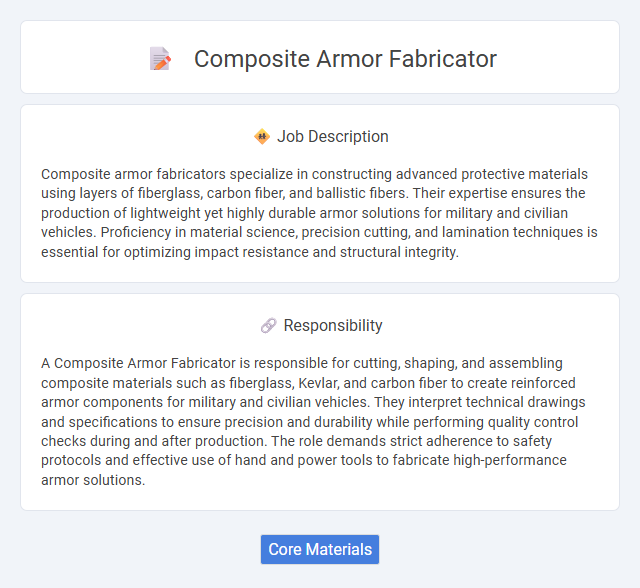
Composite armor fabricators specialize in constructing advanced protective materials using layers of fiberglass, carbon fiber, and ballistic fibers. Their expertise ensures the production of lightweight yet highly durable armor solutions for military and civilian vehicles. Proficiency in material science, precision cutting, and lamination techniques is essential for optimizing impact resistance and structural integrity.
Individuals with strong attention to detail and good manual dexterity are likely to be well-suited for a Composite Armor Fabricator position, as the role demands precise fabrication of protective materials. Those who can work effectively in physically demanding environments and maintain focus during repetitive tasks probably find this job compatible with their skills. Candidates with a preference for hands-on technical work and adherence to safety protocols might thrive in this occupation.
Qualification
A Composite Armor Fabricator requires expertise in advanced materials and manufacturing processes, typically demanding a high school diploma or equivalent with specialized training in composite fabrication techniques. Proficiency in reading blueprints, operating CNC machines, and performing quality inspections ensures precise assembly of armor components. Experience with safety protocols and knowledge of resin infusion, lamination, and curing processes enhance the ability to produce durable, high-performance composite armor systems.
Responsibility
A Composite Armor Fabricator is responsible for cutting, shaping, and assembling composite materials such as fiberglass, Kevlar, and carbon fiber to create reinforced armor components for military and civilian vehicles. They interpret technical drawings and specifications to ensure precision and durability while performing quality control checks during and after production. The role demands strict adherence to safety protocols and effective use of hand and power tools to fabricate high-performance armor solutions.
Benefit
Working as a composite armor fabricator probably offers strong job security due to the increasing demand for advanced protective materials in military and automotive industries. Benefits likely include hands-on experience with cutting-edge composites and potential opportunities for skill development in innovative manufacturing techniques. Pay and healthcare packages might be competitive to attract skilled workers in this specialized field.
Challenge
Composite armor fabricator jobs likely involve complex challenges due to the precision required in layering advanced materials to ensure maximum protection. The probability of encountering difficulties in working with diverse composites, such as ceramics, fibers, and resins, is high, demanding strong technical skills and attention to detail. These challenges may be further intensified by strict safety standards and the need for continuous quality assurance throughout the fabrication process.
Career Advancement
Working as a composite armor fabricator offers significant opportunities for career advancement through acquiring specialized skills in advanced materials and fabrication techniques. Mastery in handling high-performance composites, precise cutting, and assembly can lead to roles in quality control, project management, or research and development within the defense and aerospace sectors. Continuous training and certification in new composite technologies enhance prospects for leadership positions and higher salary brackets.
Key Terms
Core Materials
Composite armor fabricators specialize in manufacturing protective materials using advanced core materials such as aramid fibers, ultra-high-molecular-weight polyethylene (UHMWPE), and ceramic composites. These core materials provide superior ballistic resistance, lightweight strength, and enhanced durability for military and defense applications. Expertise in layering and bonding techniques ensures the final armor meets stringent performance and safety standards.
 kuljobs.com
kuljobs.com